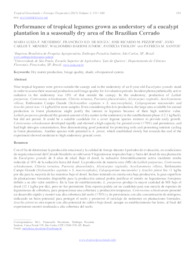Performance of tropical legumes grown as understory of a eucalypt plantation in a seasonally dry area of the Brazilian Cerrado.
Performance of tropical legumes grown as understory of a eucalypt plantation in a seasonally dry area of the Brazilian Cerrado.
Autoria: NICODEMO, M. L. F.; SOUZA, F. H. D. de; PEZZOPANE, J. R. M.; MENDES, J. C. T.; BARIONI JUNIOR, W.; THOLON, P.; SANTOS, P. M.
Resumo: Nine tropical legumes were grown outside the canopy and in the understory of an 8-year-old Eucalyptus grandis stand in order to assess their seasonal production and forage quality for 4 evaluation periods. Incident photosynthetically active radiation in the understory was 18% of that outside the canopy. In the understory, production of Lablab purpureus, Centrosema schiedeanum, Clitoria ternatea, Pueraria phaseoloides, Alysicarpus vaginalis, Aeschynomene villosa, Estilosantes Campo Grande (Stylosanthes capitata + S. macrocephala), Calopogonium mucunoides and Arachis pintoi was <1 kg/ha/d for most samples. Even considering this low production, the large area available for animal production in forest plantations might justify the interest in legumes because of their high nutritive value. Lablab purpureus produced the greatest amount of dry matter in the understory in the establishment phase (12.1 kg/ha/d), but did not persist. It could be a suitable candidate for a cover legume species mixture to provide early growth. Centrosema schiedeanum developed rapidly and showed a high capacity for ground cover (>70%) and persistence, and had high nitrogen concentration, thus demonstrating good potential for protecting soils and promoting nutrient cycling in forest plantations. Another species with potential is A. pintoi, which established slowly but towards the end of the experiment showed moderate to high understory ground cover.
Ano de publicação: 2015
Tipo de publicação: Artigo de periódico
Unidade: Embrapa Pecuária Sudeste
Palavras-chave: Dry matter production, ILPF, Silvopastoral system
Observações
1 - Por padrão são exibidas publicações dos últimos 20 anos. Para encontrar publicações mais antigas, configure o filtro ano de publicação, colocando o ano a partir do qual você deseja encontrar publicações. O filtro está na coluna da esquerda na busca acima.
2 - Para ler algumas publicações da Embrapa (apenas as que estão em formato ePub), é necessário ter, no celular ou computador, um desses softwares gratuitos. Sistemas Android: Google Play Livros; IOS: iBooks; Windows e Linux: software Calibre.
Acesse outras publicações
Acesse a Base de Dados da Pesquisa Agropecuária (BDPA) para consultar o acervo completo das bibliotecas da Embrapa.

